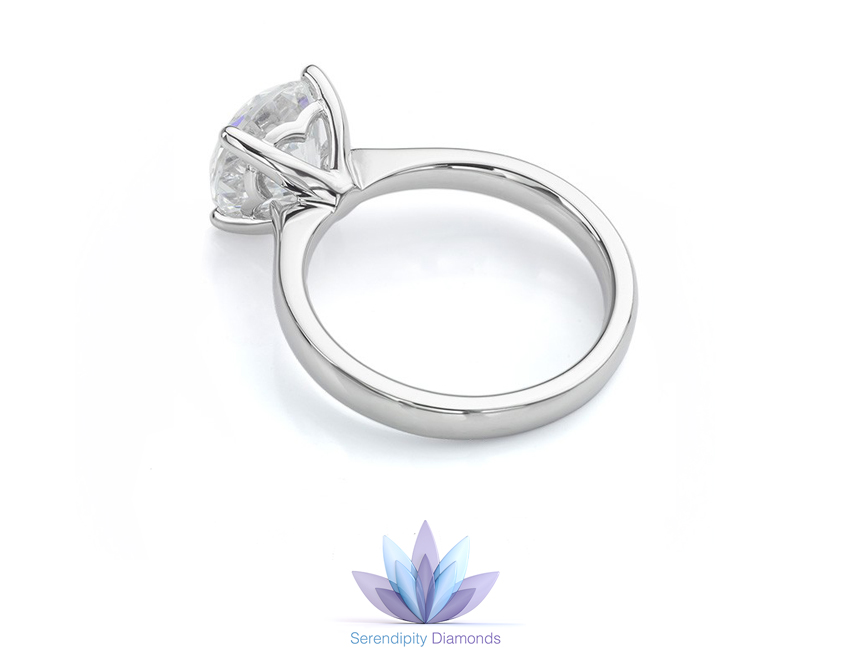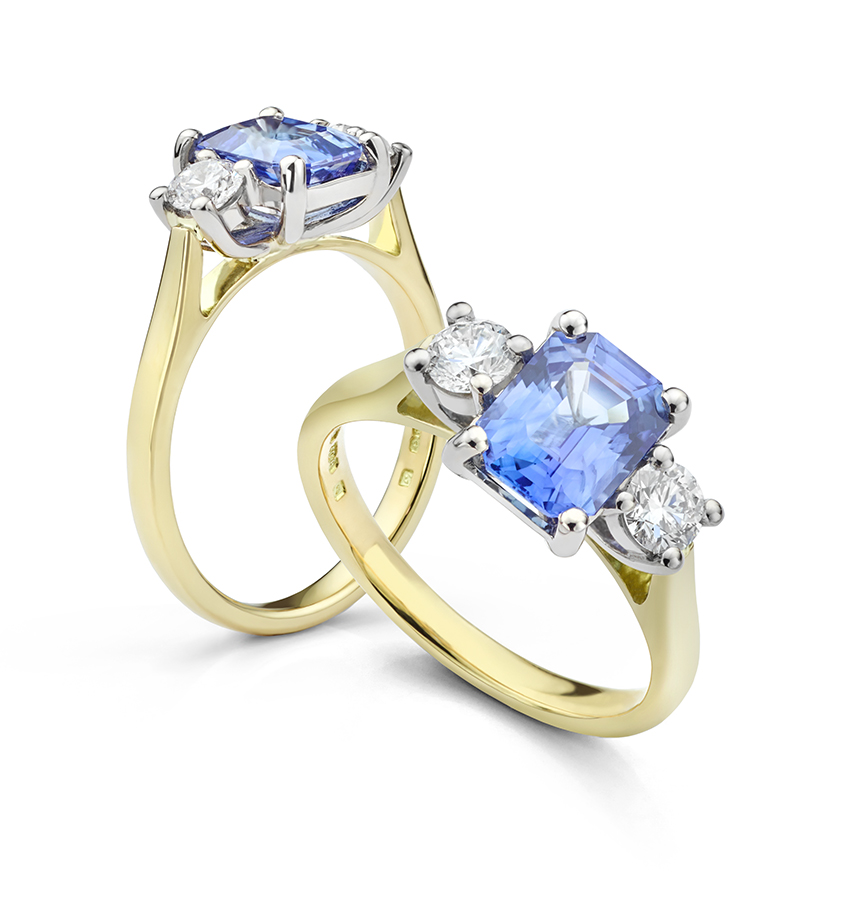Is there such a thing as a durable diamond setting?
Durability is an important question when choosing an engagement ring. Few people consider just how durable their chosen design will be. Most durable diamond settings are only durable to a degree. Few diamond ring settings will endure regular hard wear and abuse.
Here we will look at several factors to consider—each worthy of note when deciding upon how practical your ring will be for daily wear. Don’t dwell entirely on durability. Few people want an ugly engagement ring, so be sensible. Find a balance but consider some important factors.
Care must be taken with any piece of fine diamond jewellery. Few pieces of jewellery will withstand regular abuse when knocked and scraped. Jewellery withstanding heavy wear will show abuse and neglect through scuffs, scrapes and gouges. The shine and sparkle will fade, resulting in a lacklustre version of the original item.
Refurbishment can often restore a piece of jewellery to its former appearance, but regular care offsets the need for regular attention. Furthermore, consideration of the design itself will help reduce the risk when a ring is worn daily.
Consider each of the following points for durable diamond settings.
Simplicity Of Design
It stands to reason that fewer things can go wrong with a simple design. Ring settings with elaborate diamond shoulders run the risk of greater damage compared to a simple solitaire style.

The Lila design – simple elegant styling
Weight Of Claws
Engagement rings with substantial, heavy or weighty claws will be more durable than rings with fine claws. Strike a balance between the thickness of each claw and the overall appearance. Too heavy and a smaller diamond can appear swamped.
Our main image above shows the substantial Berlin engagement ring design, styled with strong secure claws.
Number Of Claws
The more claws surrounding the diamond, the greater a diamond’s security. Ring settings with two, three or four claws will be more at risk than a six claw setting. Durable diamond settings tend to have more claws to protect the diamond.

Durable Metals
All precious metals scratch and can be damaged. But some choices offer greater durability. White Gold is typically finished with a hard white Rhodium plating. This outer plating wears with time but gives protection for the gold beneath.
On the other hand 950 Platinum bears its natural grey-white metal surface, it can be restored to the as-new finish despite scratching and marking over time. Being less malleable than Gold, Platinum offers greater rigidity for holding diamonds—claws are less likely to bend with regular wear.
Sterling silver is one of the metals that we don’t recommend for engagement rings. It is not hard enough to protect stones or diamonds. Not only that, but silver remains a soft metal which, over a short time of wear, will bend out of shape and eventually snap.
Therefore, for a lower budget option, we offer the option of 9ct gold.
Setting Height
Few people consider the practicality of height when buying a diamond ring setting. Higher ring settings sit proudly on the finger. They are more exposed and subject to greater risk whilst being worn. Consider setting styles which are lower, nearer the finger, for greater protection. Lower settings make more durable diamond settings.
Types Of Durable Diamond Settings

Bezel set Dome ring with practical secure bezel setting.
Setting styles vary from claw settings to smooth rub-over bezel settings. If you choose a traditional claw setting, ensure that the claws feel smooth. Check that your ring will not snag or catch on materials. A snagging claw might require additional polishing.
It can also suggest that the claw has been knocked or moved. Best to get this checked on an existing ring setting. The smoother rub-over or bezel setting surrounds a diamond’s outer edge offering greater protection. This setting style is not necessarily for everyone, and choices should be balanced between styling and practicality.
4 Claw Settings
Alongside the 6-claw setting, the 4-claw remains the most popular and traditional setting for engagement rings. As mentioned above, the 6 claw is seen as more secure and while it’s a strong recommendation for larger diamond-carat weights. This doesn’t need to be the case for smaller diamonds.
For example, choosing a 0.30ct diamond with a 6 claw will swamp the diamond. With lesser visibility of the table of the diamond.

Durable Diamond Settings – Talon Claws
What are talon claws?
Secondly, we look at talon claws. Becoming more and more popular for modern engagement rings, and their durability makes a favourable option. The claws themselves are flattened and pointed on the diamond table, with the additional option of having the claws line up with the facets of the diamond.
The result creates a clean, modern look, which are also very difficult to catch on clothes etc, due to the smooth finish.

8 Claws
In addition to 6 claws, clients sometimes opt for an 8-claw or even a 10-claw setting. Therefore creating the ultimate durable diamond settings. Although not always required for durability, this is more often a choice of the overall look.
Part Bezel & Claw
Tension and part bezels create the visual impact of a single-tension design. However, on their own tension settings may not fit everyone’s lifestyle. More prone to knocks and bangs, the tension design can be a tricky setting to work with.
Although it’s also one of the most popular ring settings, the option of adding a security claw can still create the same desired look.

Tension Setting
As above, a fully tension setting needs to be considered prior to commitment. We recommend clients consider their lifestyle, and if they are heavy-handed. Due to the stone or diamond being secured in place by two ridges of metal, any sideways knock or catch can work the diamond loose.
So how do you check if your tension set diamond has worked loose?
Do NOT push on the diamond with your fingernail or finger. This will danger the diamond becoming even looser. Instead, bring the ring up toward your ear and, very lightly with the other hand, tap on the back of the ring – avoiding the diamond setting.
If you hear a rattle, the diamond is loose and requires a very simple tightening. After this point, we recommend removing the ring and keeping it in a secure place to avoid further loosening or loss.

Platinum Settings
Due to platinum being one the most durable metals to protect centre stones, clients opting for yellow gold may wish to consider a platinum setting for a more secure engagement ring. Two-tone options create a striking effect, although as a standard, this is done with white gold; the option for a platinum head/setting creates a stronger finish.

Lifetime Warranty and Jewellery Insurance
In summary, besides the above notes, we must consider some important details when purchasing an engagement ring. For any valuable diamond engagement ring, a lifetime manufacturing warranty (which accompanies all diamond jewellery purchases at SD) is a bonus.
Ensure you have an insurance policy for your jewellery and any lifetime warranty. By ticking both boxes, your item will be covered for any potential manufacturing defects, accidental loss and damage for complete peace of mind.

About Mark Johnson
My name is Mark and I'm founder at Serendipity Diamonds. I have 30 years or experience in polished diamonds and jewellery. Today, I work with an expert team in our Isle of Wight jewellery showroom located in Ryde. Most of my work involves helping clients in our showroom, working on our two websites and photographing jewellery commissions.



